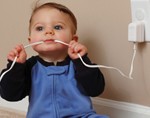Child Proofing Tips At Home
 Whether you have a baby already or if one is on the way, childproofing your house is a must and it goes without saying. It may seem like a frightening task at times, but when you consider some of the information regarding child injuries at home, you begin to realize that even the smallest prevention measures go a long way. It could be as small a safety pin or as big as a water filled bucket in the bathroom but when it comes to your little one, the stakes are high.
Whether you have a baby already or if one is on the way, childproofing your house is a must and it goes without saying. It may seem like a frightening task at times, but when you consider some of the information regarding child injuries at home, you begin to realize that even the smallest prevention measures go a long way. It could be as small a safety pin or as big as a water filled bucket in the bathroom but when it comes to your little one, the stakes are high.
If you plan child proofing your house on your own, like it’s always practiced everywhere, be sure of considering the various hazards and remedies too. It’s important to note here that irrespective of the age of your child, it is imperative to proof your house if you think your child needs it.
Hazards or dangers could be numerous provided you know of them and understand how well to keep your little one out of it. With stoves, toddler hands are at just the right height to reach the burners, pot handles and sometimes even the knobs. Ovens can be opened and crawled into, whether on or off. Dishwashers can be opened and often contain sharp objects such as knives or breakables like glassware. Refrigerators contain many items that pose choking hazards and they are airtight, which could cause a child to suffocate if they managed to crawl inside and shut the door.
Bathrooms could be worse than the above. Soaps and detergents which your child could simply gulp without a second thought could end up taking his life in the bargain. Similarly cabinets and drawers contain a huge number of perils including sharp objects, chemicals, medications, and items that could pose a choking hazard. For that matter many plants are poisonous and can cause illness or death. Potting materials pose a choking hazard.
Hence the best way to begin with childproofing your house is by keeping the bathroom doors closed and the bottles inside should be out of your child’s reach. Make sure that the oven is always switched off to avoid any accident while its belongings should be kept away under lock and key in the kitchen. Install locking latches on all appliances that open and close. Install knob covers to prevent a child from turning on burners and a stove guard to protect hands. Always keep pot handles turned inward while cooking.
Put all vases and other dangerous decorations out of your child’s reach. It may be tempting to leave some items out in order to “teach” your child about off-limits objects, but it’s safer (and less frustrating) in the long run to just remove them.
Lastly, teach your child to never put anything in his mouth without asking or knowing. This way he would always take care by not stuffing his mouth with anything dicey.